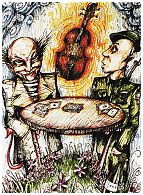
Igor Stravinsky
Igor Stravinsky's life (1882-1971) spanned a world of musical change, and probably no other composer wrote in as many styles as did he.
His early compositions mirrored the nationalist ideals of his teacher Rimsky-Korsakov, but he quickly moved on to develop his own style. With his trio of ballets
Firebird,
Petrouchka, and
The Rite of Spring Stravinsky almost single-handedly invented modernism. He later went through a neoclassical period, and finished his career embracing the serialism and twelve-tone principles of Schoenberg.
The Soldier's Tale comes from 1918, a lean post-war time when jazz was just beginning to emerge into the mainstream. Stravinsky was broke, deprived of his royalties because of the Revolution, and his other source of income, Diaghilev's
Ballets Russes was also going through lean times.
Stravinsky invented a new style, pared down to essentials, in melody, rhythm and instrumentation.
The Soldier's Tale is scored for just seven instruments: clarinet, bassoon, cornet, trombone, violin, double bass and percussion. The concert version also features four speaking parts, those of the Devil, the Soldier, a Princess and an unseen Reader. The Devil and Princess are also required to dance.
What we have on this CD is the most-commonly played concert suite for the 7 instruments without voice.

The Soldier's Tale
The story is a dark Faustian fable about a deserting soldier and the Devil who eventually possesses his soul. The soldier's violin becomes a symbol of both the soldier's soul and the Devil's wiles.
The story is based on an old Russian folk tale but the music is as far removed from Russian traditionalism as possible, making it a lesson for all cultures and times.
The most obvious sound here is jazz, a form of music that Stravinsky had never actually heard. He was familiar with it through scores that his friend Ernest Ansermet had brought from America.
Stravinsky also uses tango rhythms, marches, a waltz and a chorale, never faithfully but more as an artisan uses tools to fashion something new.
The Soldier's Tale opens with the
Soldier's March, a stiff parody of militarism, as befits a deserter.
Next come the
Soldier's Violin, rhythmic, repetitive, driving and typically Stravinsky. Then come the
Little Concert and
Three Dances - Tango, Valse and Ragtime, the most musically elaborate of the works.
The Suite ends brilliantly with the
Devil's Dance, triumphant and diabolical. The violin theme now belongs to him and he owns the Soldier's soul. The Devil celebrates his victory.
The Soldier's Tale is a masterpiece of the miniature, dry and acerbic, dark yet witty, threatening but tongue in cheek.
There are lavish productions of
The Soldier's Tale played by a full orchestra. To me, this misses the entire point. The starkness of the instruments, the dryness of the melody is what creates the mood of the piece. The Chicago Pro Musica perform as it was intended - sharp, sarcastic, biting, brilliant.
Cleverly paired on this CD is a very unusual version the Rimsky-Korsakov's
Capriccio Espagnol. Clever because Rimsky-Korsakov was Stravinsky's teacher and unusual because it is scored for a similar set of few instruments. It certainly breathes new life into this cliche of classical music, and even if this is not how you want to hear it all the time, it is certainly interesting.
Two pieces of music worlds apart in style, yet linked by a common anscestry. Both masterpieces of their genre's, crisply played.
It may take a few listenings of
The Soldier's Tale before you get comfortable with it, then after a while you just can't take the raw melodic fragments and driving rhythms out of your head. Wonderful stuff in a different more primal way to any other music. Try it.
Please support Good-Music-Guide.com
by purchasing this CD using this link.

Track Listing
Igor Stravinsky
The Soldier's Tale (L'histoire du soldat)
Rimsky-Korsakov
Capriccio Espagnol (arrangement for chamber group)
Chicago Pro Musica
Easley Blackwood, Willard Elliot, Jay Friedman, Daniel Gingrich, Richard Graef, Joseph Guastafeste, Albert Igolnikov, Donald Koss
Igor Stravinsky - The Soldier's Tale (L'histoire du soldat)
- The Soldier's March
- Soldier At The Brook
- Pastorale
- The Royal March
- The Little Concert
- Three Dances: Tango, Waltz, Ragtime
- The Devil's Dance
- Grand Chorale
- Triumphal March of the Devil
Rimsky-Korsakov
- Capriccio Espagnol arranged for chamber orchestra